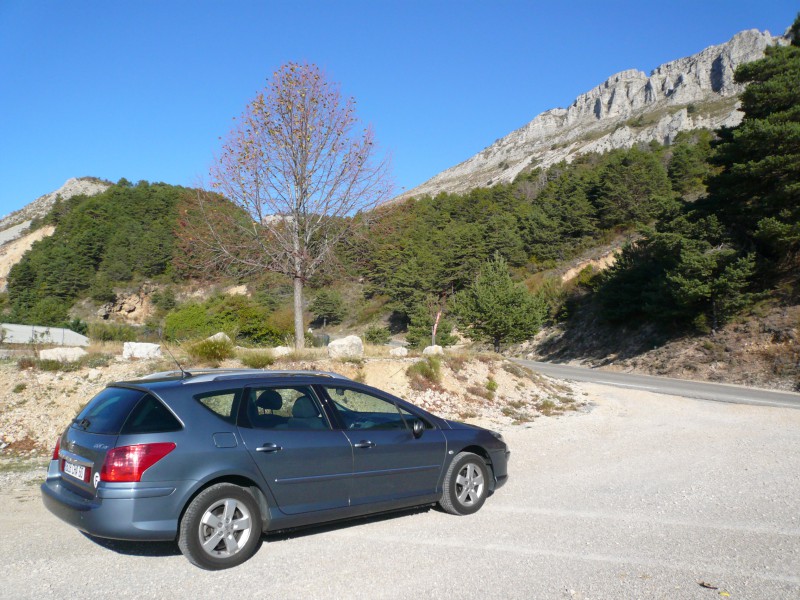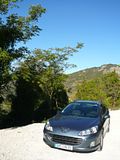
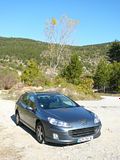
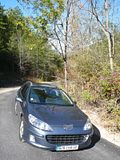
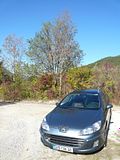

Much has been written about how Peugeot managed a special transformation from a range of cars that were both good to look at and good to drive, to a range which is neither of these. Many would contend that the transformation of the range was complete in 2004, when the rather odd looking 407 replaced the rather nice looking 406. In the intervening five years, I guess the world has got used to a car which in saloon form looks like the front and back were styled by different people who did not even get as far as sharing the dimensions with each other, so the very long snout (needed, so they said because of crash protection rule changes that took effect in 2004) appears very ill-balanced with the rather truncated rear end. The estate car, or SW in Peugeot speak, looks less clumsy, though whether you like the style of the wrap around rear windows or not must remain a matter of personal taste. I tested a 407 saloon model very soon after its introduction, when it served as holiday transport for a week in the South West of France and Andorra, and I recall that it did the job well enough, but there was no real flair or sparkle. Since that time, just about every single competitor in the market has been replaced, making the 407 one of the oldest designs in its class, so Hertz France’s offer of a 407 SW for four days on the Cote d’Azur seemed like a good chance to test the estate car version and to renew my acquaintance with the 407 itself and see if the car is still worthy of consideration in the “D” segment of the market.
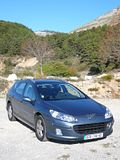
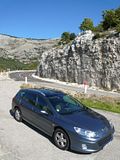
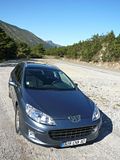
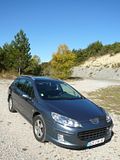
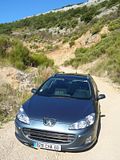
Unsurprisingly, the test car was a diesel, fitted with the well known 136 bhp 2.0 HDI engine, a unit which has provided loyal service in many Peugeot and Citroen vehicles as well as a number of Ford Europe cars. Not long ago, the PSA diesels were deemed to be the best available in mass market cars. Times have moved on, and having experienced VAG’s latest 2.0 TDi just a week ago, I could no longer give first prize to Peugeot for the motor fitted to the 407. It is not bad, and it certainly pulls well, but it is noisy at start up and in the lower gears and while accelerating. The red line is set quite low, at 4500 rpm, and as you move through the mid 3000 rpms, your ears tell you that not a lot is going to be achieved by accelerating harder and that a gear change would be a better bet. So, the gearchange: the gearlever looks just like the sort that you find in all recent Peugeots. Thankfully, the gearchange itself is better than that which I have experienced in the 407’s stablemates. It slots from gear to gear with a definite clickiness to the gearchanges, but it has none of the slop or vagueness that so afflicts the smaller models. The distance across the gate is not much, so I did find that I selected sixth instead of fourth a couple of times when changing down out of fifth. Sixth gear really is only useful for steady speed cruising on the autoroute, and in the day up in the mountains on Route Napoleon, I don’t believe I selected it (intentionally) a single time.
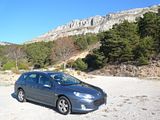


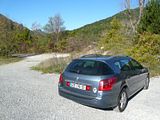

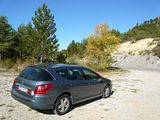
Unlike previous generation Peugeots, the 407 will win no prizes for its driving dynamics. There’s nothing wrong with it, but once you’ve sampled a Ford Mondeo, you know what can be done. Light and slightly vague feeling steering allows you to steer the front wheels all the way to a certain amount of understeer and roll, and the curves of Route Napoleon are a good way to find out that this is indeed the case. To extent, there is the compensation that the ride is good. Perhaps not as soft as the wallowy standards of French cars of yore, but certainly not the hard unyielding standards that are so often found on cars with large wheels and sports suspension. 16″ wheels doubtless help the cause here. Along with the low noise levels in sixth gear, the 407 would make for a relaxed autoroute cruiser, for sure, but not perhaps a car in which to have any fun. The test car came with a glass roof which extended more or less the entire length of the roof. This can be covered with a blind, which is rolled back in a series of 8 stages by turning the knob mounted in the centre of the roof by the interior courtesy lights. So doing makes the car feel particularly light and airy inside, though even with the roof closed, there is quite a lot of glass, starting with the front quarterlights and extending all the way to those wraparound rear side windows. Seeing out of the 407, therefore is not an issue. Seeing what is around you is not so good as the door mirrors are really very small indeed. They fold flush into the car when it is locked, and as soon as you unlock it, they power back out ready for use.

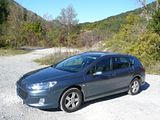
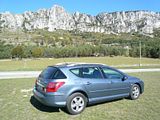
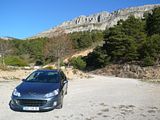
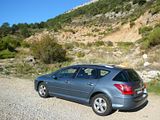
Inside the cabin, there is little doubt that this is a Peugeot. The driver’s view is dominated by a huge and ugly steering wheel boss, unrelieved save for a small plastic lion in the middle, but which is slightly convex as if the airbag was stuffed into a space that was not quite large enough for all the material. Although it would not win any prizes for quality of either design or materials, the dashboard moulding is of a reasonable standard. The massive lump of black plastic, which stretches well forward to the base of the windscreen appears to be solidly made, of relatively hard plastics with an unremarkable texture. The central part of the dash is finished in a sort of fake brushed aluminium which does not look too bad, and there are silver strips of a different texture on the doors and passenger side of the dash, which have a sort of rough effect which is intended to look like small holes. It is a definite improvement on previous generation Peugeot, but nothing to trouble Volkswagen, or even Skoda.


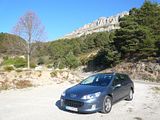
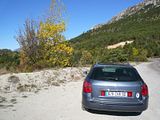
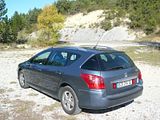
A single binnacle contains the dials, which amount to two large ones, for speedometer and rev counter and smaller ones for fuel level, oil and water temperature. They are clearly marked. There are two column stalks to do indicators, lights and wipers, these last two having an auto setting which proved useful. The centre of the dash contains controls for the stereo system and climate control, along with a display unit. At first glance it is all a bit complicated, but studying it for a few minutes, and all appears in fact to be rather straightforward. There are additional stalks on the column for remote operation of the stereo, as well as the cruise control functions. One unusual feature concerns the wipers, which are of the reverse clap hands design, meaning that an area right to the screen pillar is swept, and – thankfully, for this is usually the weakness of this arrangement, there is still good coverage right in the upper centre of the screen.

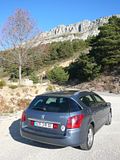
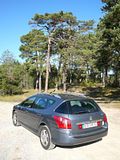
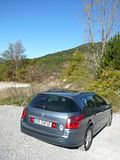
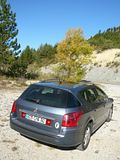
French cars have always majored on comfort, so you would hope that the 407 would score high marks here. Sadly, I could not get the driving position right. The wheel does adjust in and out as well as up and down, but by the time I had got the seat in the right place for the pedals, I found the wheel still protruding out too far. The seat backrests adjusts in a series of steps, which is never ideal, though with a height adjuster, I could at least get it low enough. The seats themselves proved comfortable, and are trimmed in better materials than you often find in cars of the class these days.
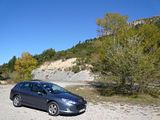
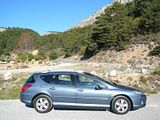
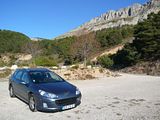
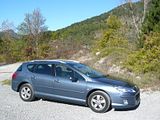
Large Peugeot estates used to be synonymous with massive carrying capacity, as those who remember the 504 and 505 will attest. Peugeot told the world that the 407 was more focused on style than ultimate carrying capacity, but it is still pretty spacious inside. There is ample room for 3 adults in the rear seats of the car and there is a generous sized boot behind them. This can be covered with a folding tonneau which has two folding flaps at the end, so you can leave the rearmost part of the luggage area that bit easier to access if you want. The whole thing is easily removed, which you will want to do should you decide to fold the asymmetrically split rear seats.The rear seat cushions cantilever forwards and up to form a partial barrier to the front seats then the rear seat cushions drop down into the space provided (making sure you have swivelled the seat belt catches down flush with the floor first), leaving a long area that is not quite flat (it rises up slightly towards the middle of the car). Inside the cabin there is a good sized glove box, and door bins, along with a completely useless little area under the central digital display, which despite its non-slip rubber mat, would not hold anything much in place for long. The central armrest is just that. Pressing the lever which I thought would open it just pantographs it forwards somewhat. There is a single cupholder along the central pull-up handbrake, lurking under a cover.
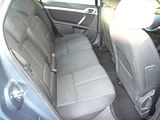
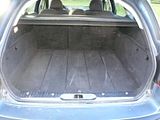
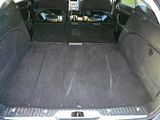
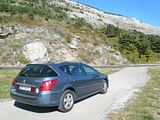
Along with the dubious dynamics and polarising styling, Peugeot have also been struggling with reliability levels in their recent cars, and a strong of bottom 10 placings in numerous consumer surveys cannot have helped them. Whereas the build quality that used to be so fragile in the days of the “x05” generation cars appears to have been attended to, I do have to wonder about the electronics. Having lowered the driver’s window for the peage on the night I collected it, the window seemed resolute that it was not going to go up again, making half the journey before retreating back to fully open. Fearful I would have to go back to the airport and return the car that night (it was raining), I had one last go and it did close properly, and did not repeat the problem during the test. On another occasion, when getting in and putting the key in, the radio came on all of its own accord, even though I had driven it for a whole day without it being in operation at all. Most odd. Such gremlins simply can’t be accepted in modern day cars now.
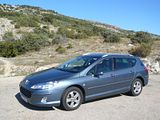
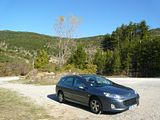
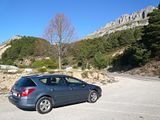
As I handed the 407 back, I had to conclude that it is a decent enough car. There is nothing seriously wrong with it, and indeed it would appear to be far more competitive than the 207. The market thinks otherwise, though, as the small car sells in huge volumes against a raft of much more able competitors, whereas even in France, the 407 struggles in the market, attaining 47th place in the French best sellers list in September 2009, outsold by C5, Laguna and Passat (but not Mondeo and Insignia). Those who are looking for a relaxed cruiser with a large boot should perhaps not dismiss it completely out of hand, though were such purchasers to head to their nearest Ford, or maybe even Vauxhall, VW or Citroen garage, I think I could understand why. It is widely rumoured that a successor to this car, doubtless the 408, is probably not much more than a year away, and it is said that it will be rather better to look at. If Peugeot can get some of the fun back into the driving as well, they will deserve success. Without it, I am sure they will continue to struggle in this class.
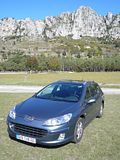

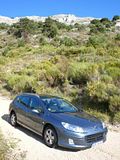
2009-10-23 19:22:11













































